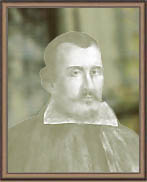Antonio de León Pinelo facts for kids
Quick facts for kids
Antonio de León Pinelo
|
|
|---|---|
 |
|
| Died | 1660 |
Antonio de León Pinelo (born in 1589, died in 1660) was an important historian from Spain who lived during the time when Spain ruled many parts of America. He was born in a place called Cordova de Tucuman, which is now in Argentina.
Antonio came from a family known as "conversos," meaning they were Jewish but had converted to Christianity. He studied at a special school run by the Jesuits in Lima, which is now the capital of Peru.
In 1612, he traveled to Spain. There, he started working for the government, specifically for the "Council of the Indies." This council was in charge of managing Spain's colonies in the Americas. Later, he became a judge in Seville. In 1658, he took on the important job of being the official historian for the "Indies." He passed away in Seville.
Antonio de León Pinelo had an interesting idea: he strongly believed that the Biblical Paradise, or the Garden of Eden, was actually located in America!
He also played a big part in organizing the many laws that governed the Spanish colonies. Back then, there were special documents called "cedularios" that helped put legal texts in order. Based on these, Spanish legal experts started writing "summaries," which were short versions of new laws or combined several laws on the same topic. Antonio de León Pinelo helped a lot with this work. He prepared a new plan for these summaries and published the first four books of them in 1628 for review.
What Antonio de León Pinelo Wrote
Antonio de León Pinelo was a very busy writer and historian. He worked on many important books and documents.
- Around 1615, he started gathering all the rules and orders that had been made for the American colonies. He published his first work about this in 1623. It was called "Discurso de la importancia, de la forma, y de la disposicion de la colleccion de las leyes de Indias." This means "A Discussion on the Importance, Form, and Arrangement of the Collection of the Laws of the Indies."
- After getting permission from the king, he searched through important historical records in Madrid and Simancas. He then published a shorter first part of his big law collection in 1634, called "Sumario de la recopilacion general." He finished the full work in 1645. However, it wasn't published until 1680 by Vicente Gonzaga. It was titled "Recopilacion general de las leyes de las Indias" and came in four volumes. This was a huge collection of all the laws for the Spanish colonies.
- In 1629, he published "Epitome de la Biblioteca oriental y occidental, nautica y geografica." This was like a summary of books about the East, West, sailing, and geography.
- He wrote "Tratado de confirmaciones reales, que se requieren para las Indias Occidentales" in 1630. This book was about the royal approvals needed for the West Indies.
- One of his most famous works, published in 1636, was "Cuestion moral si el chocolate quebronta el ayuno ecclesiastica." This translates to "A Moral Question: Does Chocolate Break the Church Fast?" It's a fun example of the detailed questions people thought about back then!
- He also created "Tablas Cronologicas" (Chronological Tables) in 1645.
- In 1656, he wrote "El Paraiso en el Nuevo Mundo" (Paradise in the New World), where he discussed his idea about the Garden of Eden being in America.
Antonio de León Pinelo also left behind many handwritten papers. Some of these were published after he died, including:
- "Politica de las Indias" (Politics of the Indies), published in 1829.
- "Bulario Indico," a code of church laws used in South America, also published in 1829.
- "Historia del Supremo Concejo de las Indias" (History of the Supreme Council of the Indies).
See also
 In Spanish: Antonio de León Pinelo para niños
In Spanish: Antonio de León Pinelo para niños


